
Related Topics
Monitor Wireless Connections (Gateway Wireless Controller)
From the Gateway Wireless Controller, you can monitor the connection status and activity on your WatchGuard APs. You can also monitor and manage the client connections to your WatchGuard APs.
- Connect to Fireware Web UI for the Firebox that manages your AP.
- Select Dashboard > Gateway Wireless Controller.
The Gateway Wireless Controller page appears, with the Summary tab selected.

- Review the Summary details for the Gateway Wireless Controller, as described in the Summary section.
- To see the locations of all APs and other wireless devices in the vicinity of your Firebox, select the Maps tab.
For more information about the Maps tab, see Use Gateway Wireless Controller Maps. - To review the status of the APs managed by this Firebox, select the Access Points tab.

- Complete any necessary tasks related to your APs, as described in the Access Points section.
- To review the status of the clients connected to the AP, select the Wireless Clients tab.

- Complete any necessary tasks related to the connected wireless clients as described in the Wireless Clients section.
- To see the external access point devices in the same geographical area as your APs, select the External BSSIDs tab.
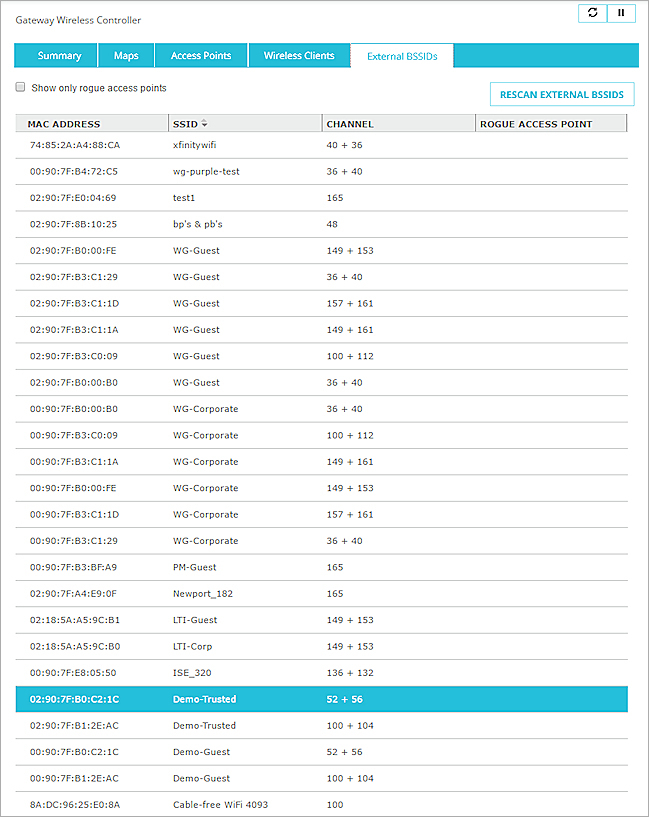
- Complete any necessary tasks related to the external access points as described in the Monitor Wireless Connections (Gateway Wireless Controller) section.
- Start Firebox System Manager for the Firebox that manages your AP.
- Select the Gateway Wireless Controller tab.
The Gateway Wireless Controller page appears, with the Access Points tab selected.
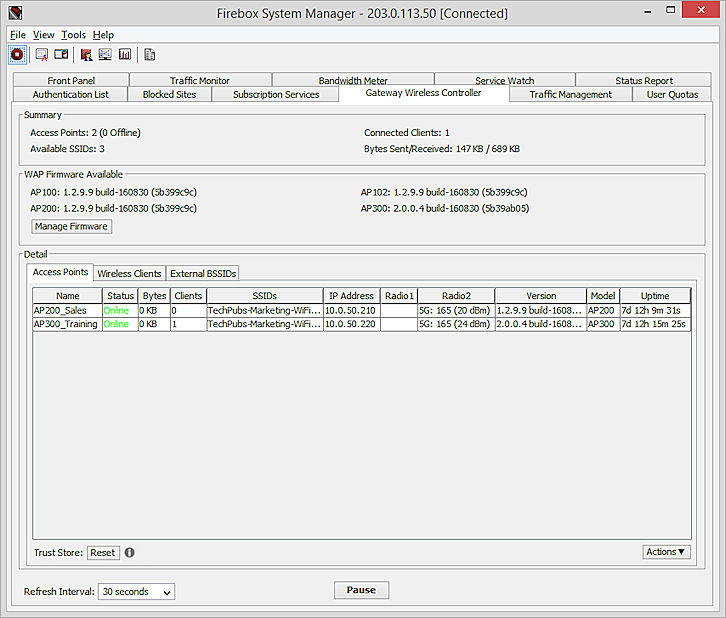
- Review the Summary details for the Gateway Wireless Controller, as described in the Summary section.
- Review the WAP Firmware Available details and check for updates to firmware on your APs, as described in the
- To review the status of the APs managed by this Firebox, on the Access Points tab, complete any necessary tasks related to your APs as described in the Access Points section.
- To review the status of the clients connected to the AP, select the Wireless Clients tab.
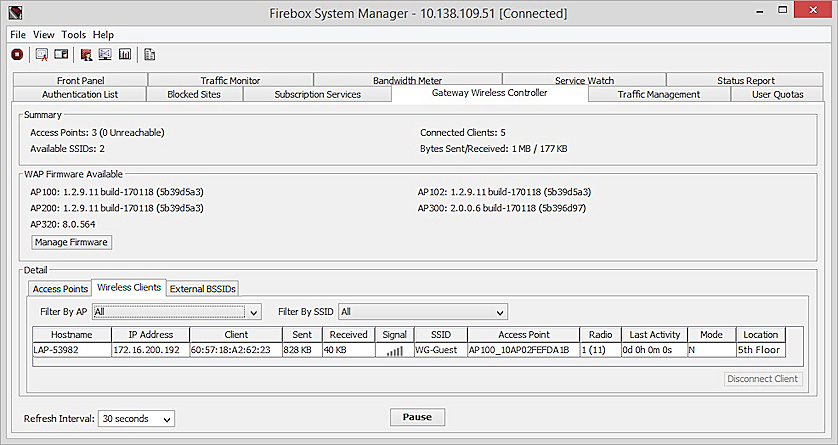
- Complete any necessary tasks related to the connected wireless clients as described in the Wireless Clients section.
- To see the external access point devices in the same geographical area as your APs, select the External BSSIDs tab.
- Complete any necessary tasks related to the external access points as described in the Monitor Wireless Connections (Gateway Wireless Controller) section.
Summary Information
The Summary section includes basic connection information for your APs and the clients connected to your APs. The information available in the Summary section is different in Fireware Web UI than in Firebox System Manager.
In Fireware Web UI, the Gateway Wireless Controller page Summary tab includes basic connection information for your APs and clients connected to your APs, as well as a list of the top ten connections for each connection category. To see more information for each connection category, you can click the header of each category widget. You can also click any item in any category widget to filter the data on the Summary tab on that item.
You can use the same method available on the Front Panel Dashboard page to see more details about connections on the Gateway Wireless Controller Summary page. To see more details about any of the information in a widget, or to pivot on the details in a widget, simply click a detail in that widget. The information in the widget is updated based on the new selection.
For example, in the Access Points list, if you click AP1, all of the other widgets are filtered to show only Top Users, Top SSIDs, and Top Manufacturers for AP1. You can then click the Top Users widget header to see the full list of users on AP1.
Total Users
This is the number of clients that are currently connected to an AP managed by this device. More detail about client connections is available on the Wireless Clients tab.
Total Bytes
The total amount of data in bytes sent and received by the connected clients.
Bytes Sent
The total amount of data in bytes sent by the connected clients.
Bytes Received
The total amount of data in bytes received by the connected clients.
Online Access Points
This is the number of APs managed by this device that are currently online and available for use.
Unreachable Access Points
This is the number of APs managed by this device that are cannot be contacted by the Firebox.
Available SSIDs
This is the number of SSIDs currently configured on your APs. You can have many SSIDs configured for each AP.
For more information about SSIDs for APs, see Configure WatchGuard AP SSIDs.
Access Point Firmware
This section includes information about the versions of firmware available for your APs. Review the available firmware versions to determine if the versions of firmware on your APs is outdated.
Check for Updates
Use this option to see the Access Point Firmware updates that are available for your APs and download the available updates from WatchGuard. For more information, see the Monitor Wireless Connections (Gateway Wireless Controller) section.
Top Users
This is the list of connected users that use the most bandwidth. For each user, the MAC Address, bytes sent, bytes received, and total number of bytes appear.
Top Access Points by Bytes
This is the list of the connected APs that use the most bandwidth. For each AP, the name of the AP, bytes sent, bytes received, total number of bytes, and number of connected users appear.
Top Access Points by User
This is the list of the connected APs with the most connected users. For each AP, the name of the AP, bytes sent, bytes received, total number of bytes, and number of connected users appear.
Top SSID by Bytes
This is the list of the SSIDs that use the most bandwidth. For each SSID, the name of the AP, bytes sent, bytes received, total number of bytes, and number of connected users appear.
Top SSID by Users
This is the list of the SSIDs with the most connected users. For each SSID, the name of the AP, bytes sent, bytes received, total number of bytes, and number of connected users appear.
Top Manufacturers by Bytes
This is the list of wireless network interface manufacturers for connected wireless clients that use the most bandwidth. The manufacturer name might be different from the brand of the wireless client device.
For each device manufacturer, the bytes sent, bytes received, total number of bytes, and number of connected users appear.
Top Manufacturers by Users
This is the list of wireless network interface manufacturers for wireless clients that have the most connected users. The manufacturer name might be different from the brand of the wireless client device.
For each device manufacturer, the bytes sent, bytes received, total number of bytes, and number of connected users appear.
In Firebox System Manager, the Summary section of the Gateway Wireless Controller tab includes basic connection information for your APs and clients connected to your APs.
Access Points
This is the number of APs managed by this Firebox that are currently online and available for use.
APs managed by this device that are currently not online and are unavailable for use appear in parenthesis.
Available SSIDs
This is the number of SSIDs currently configured on your APs. You can have many SSIDs configured for each AP.
For more information about SSIDs for APs, see Configure WatchGuard AP SSIDs.
Connected Clients
This is the number of client computers that are currently connected to an AP managed by this device. More detail about client connections is available on the Wireless Clients tab.
Bytes Sent/Received
The total amount of data in bytes sent and received by the connected clients.
The WAP Firmware Available section shows the current AP firmware versions that are available for each AP model. You can check for available firmware updates for your AP, and then upgrade the firmware on your AP from the Gateway Wireless Controller. For more information, see the Firmware Updates and Upgrade sections.
Firmware Updates
In the Gateway Wireless Controller, you can see the versions of firmware available for each of your AP models. You can download new versions of the firmware for each of your AP models to your Firebox and upgrade the firmware version on each of your APs.
- On the Summary tab, in the Summary section, click Manage Firmware.
The Access Point Firmware dialog box appears, with a list of AP models, the current version of AP firmware installed on the Firebox for each AP model, and the version available for each AP models.
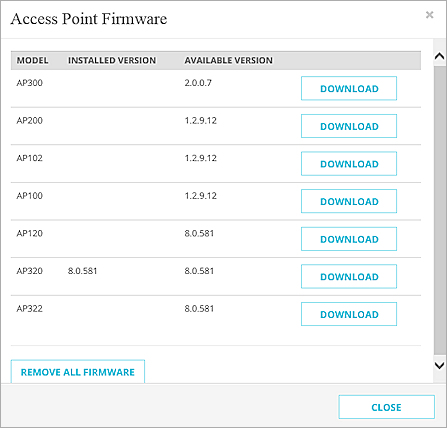
- Review the Installed Version and Available Version for each of your AP models.
- To remove the current versions of firmware on your Firebox for all AP models, click Remove All Firmware.
- To download the available firmware version for an AP model, adjacent to that model, click Download.
A downloading message appears. When the firmware has download ed to your Firebox, a download completion message appears. - Click Close.
You can now upgrade the firmware version you downloaded to each of your APs of that model, as described in the Upgrade section.
- In the WAP Firmware Available section, click Manage Firmware.
The Access Point Firmware dialog box appears, with a list of AP models, the current firmware version on your Firebox for each AP model, and the version available for each AP models.
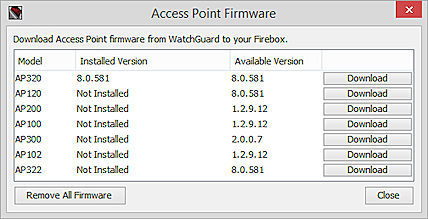
- Review the Installed Version and Available Version for each of your AP models.
- To remove the current versions of firmware on your Firebox for all AP models, click Remove All Firmware.
- To download the available firmware version for an AP model, adjacent to that model, click Download.
The Access Point Firmware dialog box appears. If you are not logged in as a user with Device Administrator credentials, you must provide Device administrator credentials before you can download the firmware updates to your Firebox. - In the User Name and Passphrase text boxes, type the user credentials for a user account with Device Administrator credentials.
A downloading message appears. When the firmware has download ed to your Firebox, a download completion message appears. - Click Close.
You can now upgrade the firmware version you downloaded to each of your APs of that model, as described in the Upgrade section.
Access Points
On the Gateway Wireless Controller Access Points tab in Fireware Web UI and Firebox System Manager, you can see all of the APs that are managed by your Firebox. For each AP, this information appears:
Name
This is the unique, friendly name you assign to the AP when you add or edit an Access Point in the Gateway Wireless Controller configuration settings.
Status
In this column, the current status of each AP paired with this Firebox appears.
- Online — The AP is enabled and can communicate with the Firebox.
- Not Trusted — The AP is not in a trusted state. For more information, see AP Trust Store.
- Unreachable — The AP cannot be contacted by the Firebox.
- Discovered — The AP has been discovered by the Firebox, but is not yet online.
- Updating Firmware — The AP firmware is being updated.
- Updating Configuration — An update to the AP configuration is in progress.
- Authenticating — The AP is authenticating to the Gateway Wireless Controller. If the status does not change from Authenticating to Online, the passphrase on the AP may not match the passphrase on the Gateway Wireless Controller. For information about how to resolve a passphrase mismatch, see About AP Passphrases.
- Cloud Managed — An AP on your network that is managed by WatchGuard Wi-Fi Cloud and not the Gateway Wireless Controller.
Bytes
The number of bytes of data through the AP.
Clients
The number of client devices connected to the AP.
SSIDs
This column shows the name of each SSID you have configured for the APs paired with this Firebox.
For more information about SSIDs for APs, see Configure WatchGuard AP SSIDs.
IP Address
This is the IP address assigned to the AP.
Radio 1
This column shows the radio frequency and channel that the AP Radio 1 uses.
For more information about radio settings, see Configure AP Radio Settings.
Radio 2
If your AP has two radios, this column shows the radio frequency and channel that the AP Radio 2 uses.
For more information about which APs have dual radios, see About AP Configuration.
Version
This is the firmware version on the AP.
Model
This is the model number for the AP.
For more information about the available AP models, see About AP Configuration.
Uptime
The amount of time the AP has been online.
For each AP in the Access Points list, you can also select an option from the Actions drop-down list to complete these tasks:
Site Survey
To detect other active wireless access points in the same area, you can complete a site survey.
- From the Access Points list, select the AP.
- From the Actions drop-down list, select Site Survey.
For more information about how to perform a site survey, see the Perform a Site Survey section in the topic Monitor AP Status.
Log Messages
To see the syslog log messages generated by an AP:
- From the Access Points list, select the AP.
- From the Actions drop-down list, select Log Messages.
Network Statistics
To see a report of network statistics information from the AP:
- From the Access Points list, select the AP.
- From the Actions drop-down list, select Network Statistics.
The network statistics report includes interface statistics (names, MAC and IP addresses, and traffic counters), routing table details, and ARP table details for the AP.
Flash Power LED
To make the power LED on the AP flash:
- From the Access Points list, select the AP.
- From the Actions drop-down list, select Flash Power LED.
The Flash Power LED dialog box appears. If you are not logged in as a user with Device Administrator credentials, you must provide Device administrator credentials. - In the User Name and Passphrase text boxes, type the user credentials for a user account with Device Administrator credentials.
- Click OK.
The LED flashes for several minutes.
This is helpful when you need to identify a specific AP, particularly if you use the Disable LEDs option to operate your AP in stealth mode to hide the use of wireless activity.
The Flash LED feature is supported only on AP100, AP102, AP200, and AP300 devices.
Reboot
To restart an AP:
- From the Access Points list, select the AP.
- From the Actions drop-down list, select Reboot.
The Reboot dialog box appears. If you are not logged in as a user with Device Administrator credentials, you must provide Device administrator credentials. - In the User Name and Passphrase text boxes, type the user credentials for a user account with Device Administrator credentials.
- Click OK.
The AP restarts.
Unreachable appears in the Status column for an AP while it reboots. When the AP reboot is complete, Online appears in the Status column.
To upgrade the firmware on an AP:
- From the Access Points list, select the AP.
- From the Actions drop-down list, select Upgrade.
A confirmation message appears. - Click Yes.
Trust an AP
To help prevent potential security issues from factory reset, unauthorized, or compromised APs in your deployment, the Gateway Wireless Controller will not manage or monitor an AP that is not trusted. For more information, see AP Trust Store.
To trust an AP:
- Select one or more APs.
- Click Action.
- Select Mark Trusted.
Reset Trust Store
If any of your APs might have been compromised, such as APs that have been tampered with, reset, or are no longer under your control, we recommend that you reset the Trust Store.
For more information, see AP Trust Store.
Show Password
(Fireware v12.0.2 or lower)
If automatic passphrase management is enabled, you can display the AP passphrase. To see the passphrase, select an AP, click Action, then select Show Password.
For more information, see About AP Passphrases.
Reset to Factory Default
To reset an AP to the factory-default settings:
- From the Access Points list, select the AP.
- From the Actions drop-down list, select Reset to Factory Default.
A confirmation message appears. - Click Yes.
For more detailed procedures related to the tasks you can complete when you monitor your APs, see Monitor AP Status.
Wireless Clients
On the Gateway Wireless Controller Wireless Clients tab in Fireware Web UI and Firebox System Manager, you can see a list of the client devices that are connected to your APs.
Access Point (Web UI) or Filter by AP (FSM)
To filter the list of connected client devices by the AP that each client is connected to, select an option from the Access Point drop-down list. The options include All and the name of each AP paired with this Firebox.
SSID (Web UI) or Filter by SSID (FSM)
To filter the list of connected client devices by the SSID that each client is connected to, select an option from the SSID drop-down list. The options include All and the name of each SSID that is configured on your APs paired with this Firebox.
Manufacturer (Web UI Only)
To filter the list of connected client devices by the manufacturer of the client device, select an option from the Manufacturer drop-down list. The options include All and the name of each manufacturer for the client devices connected to an AP paired with this Firebox.
Hostname
This is the host name of the client device. This column only appears if your APs use the Firebox as a DHCP server.
To sort the list by the host name, click the Hostname column header.
IP Address
This is the IP address of the client device. This column only appears if your APs use the Firebox as a DHCP server.
To sort the list by the IP address, click the IP Address column header.
To see more information about the connections for this client device, click the IP address and then click a link to see the client device: View in FireWatch or View in Traffic Monitor.

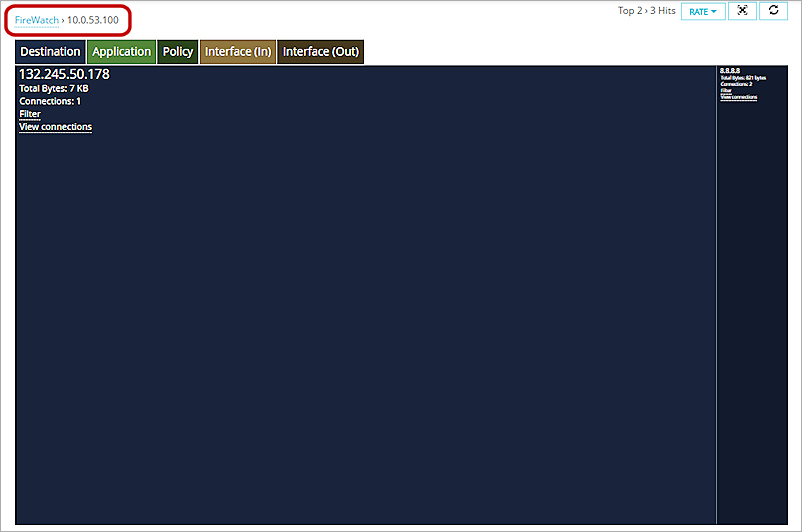
Example of the FireWatch page with only information for the selected IP address.

Example of the Traffic Monitor page with only traffic for the selected IP address.
MAC (Web UI Only)
This is the MAC address assigned to the client device. To sort the list by the MAC address, click the MAC column header.
Manufacturer (Web UI Only)
This is the manufacturer of the client device.
Sent
This is the amount of data that the client device has sent while connected to the AP.
Received
This is the amount of data that the client device has received while connected to the AP.
Signal
This shows the signal strength of the connection between the client device and the AP.
SSID
This is the name of the SSID that the client device is connected to.
Access Point
This is the name of the AP that the client device is connected to.
Radio
This column shows the radio channel on the AP that the wireless client device uses.
Mode
This is the 802.11 wireless mode that the client device uses. For example, b, N, or AC.
Location
The location of the client. This information is derived from the description of the AP to which the client is connected. In Fireware Web UI, you must select a client to see the location details.
Disconnect Client
To disconnect a client device from an AP, from the Wireless Clients list, select the client device and click Disconnect Client.
For more detailed procedures related to the tasks you can complete when you monitor Wireless Clients, see Monitor Wireless Clients.
External BSSIDs
On the Gateway Wireless Controller External BSSIDs tab in Fireware Web UI and Firebox System Manager, you can see a list of access point devices that are not part of your network. You can scan for all access point devices, or for only rogue access points. You can complete a scan to find any conflicts in your area with the SSID and channel that your wireless devices use.
- Select the External BSSIDs tab.
- If the External BSSIDs list is not automatically populated, click Rescan External BSSIDS.
The Gateway Wireless Controller scans the area and the access point devices that are not part of your network appear.
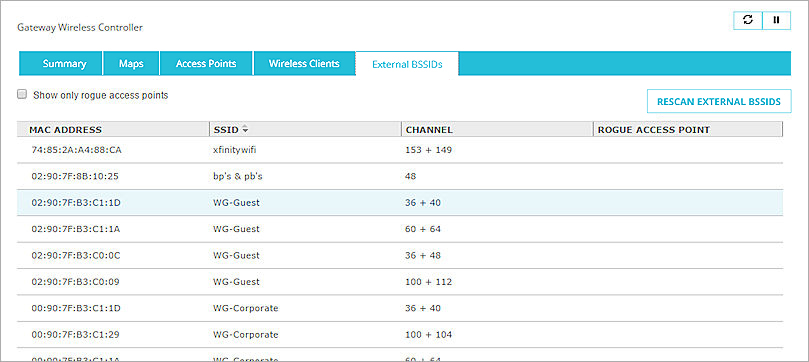
- To scan for only rogue access points, select the Show only rogue access points check box.
The list is updated to only include rogue access points.

- To update the list of external devices in the area, click Rescan External BSSIDs.
The Gateway Wireless Controller scans the area for external devices. The external BSSIDs and rogue access points in your area appear in the list, unless you select the Show only rogue access points check box.

- To sort the list by the SSID, click the SSID column header.
- Select the External BSSIDs tab.
- If the External BSSIDs list is not automatically populated, click Rescan External BSSIDS.
The Rescan External BSSIDs dialog box appears.
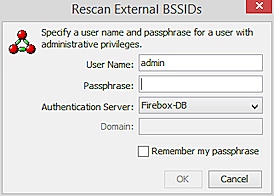
- Specify the user credentials for a user with Device Administrator privileges. Click OK.
The Gateway Wireless Controller scans the area and the access point devices that are not part of your network appear.
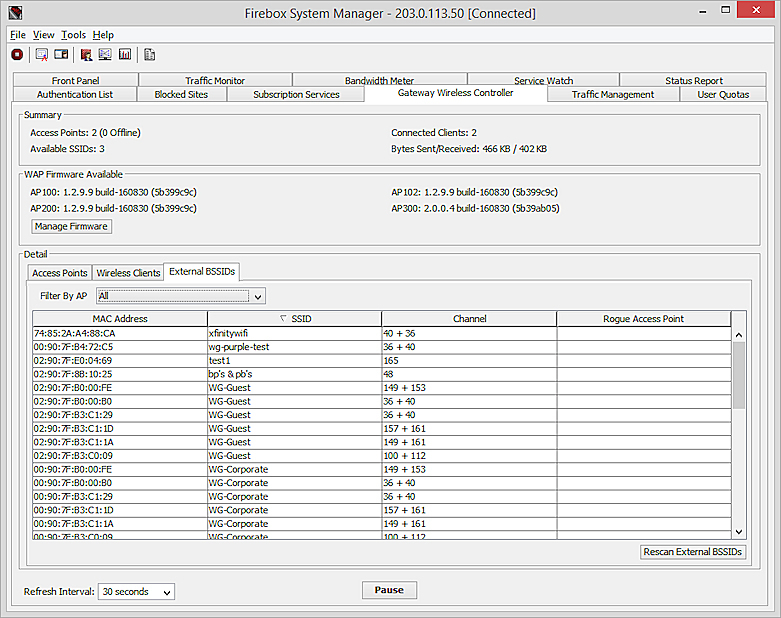
- To see only rogue access points, from the Filter by AP drop-down list, select Rogue Access Points.
The list is updated to only include rogue access points.
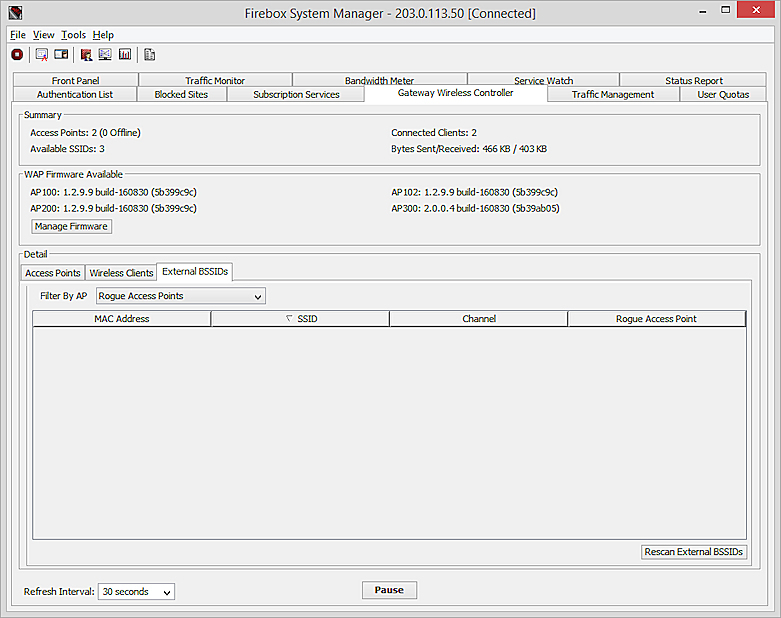
- To update the list of external devices in the area, click Rescan External BSSIDs.
The Gateway Wireless Controller scans the area for external devices. The external BSSIDs and rogue access points in your area appear in the list, unless you select to show only Rogue Access Points. - To sort the list by the SSID, click the SSID column header.
The External BSSIDs tab includes this information:
MAC Address
This is the MAC address assigned to the external BSSID or rogue access point.
SSID
This is the SSID assigned to the external BSSID or rogue access point.
Channel
This is the wireless channel used by the external BSSID or rogue access point.
Rogue Access Point
This shows an icon for the channel conflict level of the rogue access point device identified by the scan.
For more information about channel conflict levels, see Use Gateway Wireless Controller Maps.